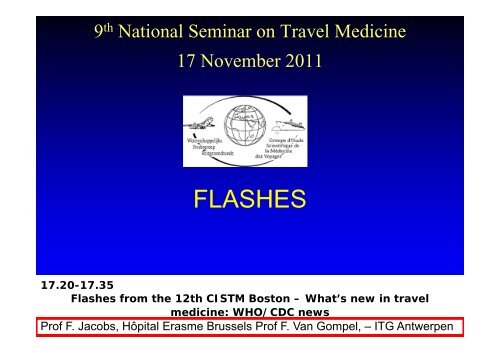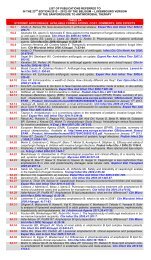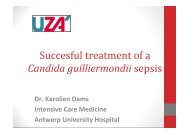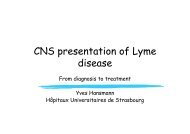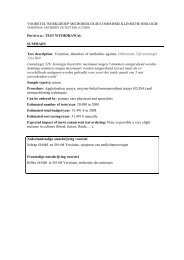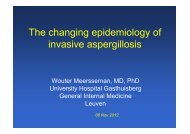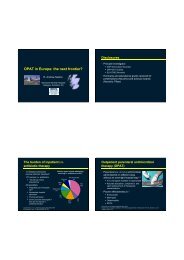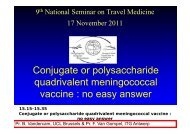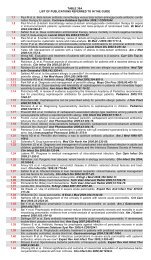Create successful ePaper yourself
Turn your PDF publications into a flip-book with our unique Google optimized e-Paper software.
9 th National Seminar on Travel Medicine<br />
17 November 2011<br />
FLASHES<br />
17.20-17.35<br />
Flashes from the 12th CISTM Boston – What’s new in travel<br />
medicine: WHO/CDC news<br />
<strong>Prof</strong> F. Jacobs, Hôpital Erasme Brussels <strong>Prof</strong> F. Van Gompel, – ITG Antwerpen
1 – CISTM 12<br />
BOSTON
CISTM12 Speaker Presentation<br />
Handouts<br />
� To download for members of the ISTM
2 – TOPICS from<br />
BOSTON<br />
Typhoid fever<br />
Yellow fever<br />
Giardiasis<br />
Rabies
Typhoid fever: resistance to<br />
quinolones<br />
• 22 million new cases annually;<br />
• 200.000 deaths annually worlwide<br />
• Greatest burden in the Indian Subcontinent and SE<br />
Asia<br />
• Pereira PO 03.11: clinical case<br />
– a 35-year-old man<br />
– admitted for typhoid fever due to<br />
– S. typhi resistant to nalidix acid but susceptible for<br />
quinolones<br />
– Relapse after 14 days of treatment with ciprofloxacine.<br />
– Cure after treatment with cefotaxime and azithromycin<br />
• The quinolone-susceptible, nalidixic acid-resistant<br />
strains may be associated with clinical failure or<br />
delayed response to quinolone<br />
It’s recommended to test for<br />
nalidixic resistance in all extraintestinal<br />
Salmonella isolates<br />
Imported<br />
cases in USA<br />
Lynch JAMA 2009
Typhoid fever<br />
• In returning travelers and immigrants seen at a Bronx municipal<br />
hospital 2005-2010 (Farmakiotis PO03.04)<br />
– 17 patients with S. typhi; median age 7y (2-47)<br />
– 16/17 required hospitalization (2 in ICU)<br />
– 82% history of recent travel (14/17 from Bangladesh and Pakistan)<br />
– None of these patients received pre-travel vaccination<br />
– Antimicrobial susceptibility<br />
• 76% (12/17) resistant to nalidixic acid<br />
• 23% (4/17) resistant to ampicillin and cotrimoxazole;<br />
• 1 was resistant to ciprofloxacine<br />
• All were susceptible to 3 rd generation cephalosporins<br />
• Combination therapy with ceftriaxone and azithromycin for<br />
Salmonella paratyphi A bacteremia among Israeli travelers to<br />
Nepal (Meltzer PO 03.08)<br />
– Outbreak occurred during October 2009 (< Chabad House in Pokhara)<br />
� 36 patients hospitalized in Israel<br />
– PFGE: single bacterial strain, all resistant to ciprofloxacin<br />
– Treatment<br />
• 12 pts: ceftriaxone for 14 days<br />
• 17 pts: ceftriaxne for 14 days + azithromycin for the first 7 days<br />
– All the patients recovered uneventfully.<br />
– Time for defervescence:<br />
• 3.2 +/- 1.7d (combination therapy)<br />
• 6.3 +/- 1.7 d (monotherapy) p=0.0006
Delayed antibody response to yellow fever vaccination in<br />
elderly coincides with prolonged viraemia.<br />
• YF vaccine:<br />
– It can cause vaccine-associated disease that ressembles wild type yellow fever (yellow fever<br />
vaccine associated viscerotropic disease (YEL-AVD)<br />
• Risk of YEL-AVD<br />
– 60-69 y: 1.1/100.000 doses x 4.4<br />
– > 70y: 3.2/100.000 x 13.4 fold higher that young adults<br />
• Droukens FC 05.06: humoral response against YF-17D in elderly subjects to<br />
investigate the mechanism of YEL-AVD.<br />
– YF primovaccination: 2 groups<br />
Young<br />
volunteers<br />
(18-28y)<br />
N of patients 30 28<br />
Day 10<br />
Seroconversion<br />
GMT<br />
Day 14<br />
Seroconversion<br />
GMT<br />
77%<br />
0.18 IU/ml<br />
100%<br />
4.8<br />
Elderly<br />
travelers<br />
(60-81y)<br />
p<br />
50%<br />
0.017 IU/ml 0.004<br />
100%<br />
2.7 0.035<br />
Viremia 60% 68% P= 0.03<br />
Viral levels + ++<br />
Elderly subject (age>60y) had<br />
� a delayed antibody response<br />
� higher viraemia<br />
We hypothesize that this allows<br />
attenuated virus to cause higher<br />
viraemia levels that may result in<br />
severe disease
Nitroimidazole resistant Giardia intestinalis in<br />
travellers<br />
• Giardiasis<br />
– Prevalence in stools: 1-20%<br />
– Waterborne, foodborne, person to person transmission<br />
– Incubation 1-2 weeks<br />
– Parasite and host factors determine the course of infection<br />
– Stool examination:<br />
• 60-80% single stool<br />
• 90% 3 stools<br />
– Examination of duodenum<br />
• Cure rate:<br />
– Tinidazole 2g once 92%<br />
– Metronidazole 250 mg tid 5-7 d 88%<br />
– Nitazoxamide 500mg tid during 3 days 90%<br />
– Alternative: quinacrine and paromomycine<br />
• Treatment failure common with all agents<br />
• Different from<br />
– True drug resistance<br />
– Cure folowed by reinfection<br />
– Acquired lactose intolerance<br />
• Munoz FC 01.02 Barcelona<br />
– 95 patients with G. intestinalis<br />
– 34% India, 3% SE Asia, 33% Sub-Saharian Africa, 24% Latin America, 4% Mediterranean basin<br />
– In 21/95 (22%), persistent Giardia after treatment.<br />
• 14 patients with quinacrine -� 100% efficacy
• Rabies cases in travelers:<br />
17 cases the last 10 years<br />
(! Philippines!)<br />
Rabies<br />
• Rabies exposure<br />
–In expatriates 6-44/1000/year 1.6/1000/month<br />
–In tourists 0.3-23/1000/year 1.9/1000/month<br />
–Overall 0.2% (0.1-2.3%) at risk of bite per month<br />
of stay in endemic countries<br />
• Risk factors (Geosentinel) 320 injuries in travelers<br />
–67% in Asia study in Marseille (North Africa)<br />
–Travel duration:<br />
• 85% < 3 months 53% < 4 weeks � short-term = long term<br />
• Bangkok >50% exposed during the first 10 days<br />
–Dogs > monkey (in Nepal monkey bites)<br />
–Younger age<br />
–Tourists<br />
• Vaccination coverage:<br />
expatriates (30%) > tourists (13%)<br />
• Price of the vaccine: 22 € (Europe) 200$ in US, Canada
Risk of possible exposure to rabies among travelers<br />
from developed countries in SE Asia<br />
(FC 07.01; Piyaphanee Bangkok)<br />
• In May 2010-Jan 2011, 3213 travelers from developed<br />
countries were invited to fill a questionnaire in the<br />
departure hall of Bangkok<br />
– They had completed their trip and were departing to<br />
destinations outside SE Asia<br />
– 70% European, 18% Australian-New Zealander, 11%<br />
American and Canadian<br />
• Up to 75% had sought health information before this<br />
trip but only 37% had received information about<br />
rabies<br />
• Rabies pre-exposure vaccination:<br />
– 15% 3 doses<br />
– 11% only 1-2 shots<br />
– 73% no vaccine<br />
• The risk of being bitten was 0.56%, and icked 3%<br />
(on the average stay of 28 days)<br />
• Among those bitten, only 20% went to the hospital to<br />
get rabies post-exposure
Rabies postexposure prophylaxis (PEP)<br />
• Uwanyiligira, Lausanne FC 07.02<br />
– 72 patients had consulted for rabies prophylaxis after potential<br />
exposure abroad<br />
– Animals responsible for exposure:<br />
• dogs (40), cats (6), monkey (18), bats (3), others (5)<br />
– 11/ (8/72) had received PEP with 3 doses of vaccine<br />
– Care abroad:<br />
• 42 patients who sought care abroad<br />
• Median Delay for PEP: 0 days (0-14 d)<br />
• Only 5/38 patients (13%) without pre-departure rabies vaccination had<br />
received Ig<br />
– Care in Switzerland:<br />
• 30 patients<br />
• Median delay for PEP: 10 days (0-327)<br />
• Of the 66 patients in whom antibody titers were available on day 21<br />
after start of PEP, 4 (6%) did not have a protective antibody titer (><br />
0.5 IU/ml)<br />
• Gautret Clin Microbiol Infect 2010; 17, 445-447<br />
– 45 injured travelers in Bali:<br />
– Most travelled<br />
• for a short time (
Immunogenicity of a modified intradermal<br />
pre-exposure rabies vaccination schedule<br />
• Intradermal vaccination:<br />
– cheaper but<br />
– recommended only if there is sufficient time to perform<br />
serology 2 to 3 weeks post vaccination and confirm<br />
immunity prior to travel<br />
• Modified intradermal schedule TRID 2:<br />
– can be completed in a shorted time compared to standard<br />
intradermal schedule:<br />
– 2 ID of 0.1 ml of human diploid cell rabies vaccine<br />
administered on day 0 and 7<br />
• 420 travelers<br />
– seroconversion rate 94.3% at 21 days post-vaccination<br />
– Antibody levels were significantly lower in the older age<br />
groups (p=0.003)<br />
• This schedule is highly effective, with similar<br />
immunogenicity to the standard intradermal schedule
Date: Wed 24 Aug 2011<br />
RABIES - USA: (NEW YORK), SOLDIER,<br />
Wed 21 Sep 2011<br />
A Fort Drum, N.Y. soldier who<br />
recently returned from Afghanistan<br />
died from rabies after contracting the<br />
disease from a feral dog while<br />
deployed
3 – update consensus<br />
2011
Update november 2011<br />
BELGIAN<br />
CONSENSUS MEETING<br />
on TRAVEL MEDICINE<br />
Belgian<br />
Scientific Study<br />
Group on Travel<br />
Medicine<br />
June 20, 2011<br />
Pr. A. Van Gompel (ITG)<br />
Pr. F. Jacobs (Hôp. Erasme, ULB)<br />
Pr. P. Lacor (UZ-Brussel)<br />
Dr. Ph. Leonard (CHU-ULg)<br />
Pr. W. Peetermans (U.Z. - K.U.Leuven)<br />
Dr. S. Callens(UZ.- U.Gent)<br />
Dr. S.Quoilin (iph.fgov.be)<br />
Dr.P. Soentjens (Belgian Army)<br />
Pr. B. Vandercam (CHU. St. Luc, UCL)<br />
Pr. Y. Van Laethem (CHU. St. Pierre, ULB)
Vaccinations
RABIES-1<br />
• Prophylactic rabies vaccine is no longer<br />
available via WIV.<br />
• Rabies vaccine is commercially available in<br />
Belgium – can easily be delivered by the<br />
pharmacists in town or in the hospitals.<br />
• According to a guideline from 1984 the<br />
“Vaccin Rabique Inactive Merieux HDCV”<br />
from Sanofi is yet reimbursed (final price<br />
about 6 euro per dose) if delivered by the<br />
pharmacist (also those in the hospitals)<br />
• The two vaccines are interchangeable and<br />
can be used for subsequent vaccination.
RIZIV - INAMI
RABIES-2<br />
• The vaccination scheme is 3 shots within<br />
one month.<br />
• So the only once needed booster dose can<br />
be given after one year or later.<br />
• This is the basis whereafter the patient<br />
remains for at least 20-30 years (probably<br />
lifelong) boostable<br />
• Every shot counts, so even if a second or<br />
third dose is delayed.<br />
• It is safe to measure the rabies antibody<br />
titer after the third shot if delayed doses<br />
where given (e.g. more than 12 months).
RABIES-3<br />
• The postexposure rabies management<br />
remains the responsibility of the<br />
WIV/IPH/ISP<br />
• After the postexposure rabies<br />
vaccination series, the same longterm<br />
(probably lifelong) boostability is<br />
present.
YELLOW FEVER<br />
2011
YELLOW FEVER<br />
2011
2010
• MAIL<br />
YELLOW FEVER
Vaccine 1998
Vaccine 2011<br />
2011
2011<br />
Combination of YF-vaccine and<br />
MMR-vaccine<br />
• Administration of two life-attenuated vaccines can be<br />
done simultaneously without relevant influence on<br />
immunogenicity.<br />
• For measles and varicella the doses, when not given<br />
simultaneously, must be separated by 30 days<br />
because of the interferon production induced by the<br />
first vaccine shot.<br />
• This is not so for the combination of measles and<br />
yellow fever vaccination.<br />
CDC says that any interval can be used if yellow fever<br />
vaccination is indicated, irrespective when measles<br />
vaccine was given previously. …….<br />
• Studies are actually ongoing that might change this<br />
advice :
combination of measles and yellow fever vaccination<br />
2011<br />
• Subjects injected YFV and MMR simultaneously<br />
had lower seroconversion rates – 90% for rubella,<br />
70% for yellow fever and 61% for mumps –<br />
compared with those vaccinated 30 days apart –<br />
97% for rubella, 87% for yellow fever and 71% for<br />
mumps.<br />
• Seroconversion rates for measles were higher<br />
than 98% in both comparison groups.<br />
• Geometric mean titers for rubella and for yellow<br />
fever were approximately three times higher<br />
among those who got the vaccines 30 days apart.<br />
• For measles and mumps antibodies GMTs were<br />
similar across groups.
combination of measles and yellow fever vaccination<br />
2011<br />
• MMR’s interference in immune response<br />
of YFV and YFV’s interference in immune<br />
response of rubella and mumps<br />
components of MMR had never been<br />
reported before but are consistent with<br />
previous observations from other live<br />
vaccines.<br />
• These results may affect the<br />
recommendations regarding primary<br />
vaccination with yellow fever vaccine and<br />
MMR.
Japanese encephalitis (Ixiaro®)<br />
• Ixiaro® is commercially available in the officinal<br />
pharmacy.<br />
• The full dose has to be used for children and<br />
adults between 3 and 18 years of age. Between<br />
the age of 1 and 3 half dose is indicated.<br />
• The standard scheme requires 2 injections,<br />
separated by one month. Afterwards, the traveler<br />
remains boostable which means that a booster<br />
dose can be given after 12-24 months – (later<br />
boosters ? 3-5 years ?)<br />
• When the patient was vaccinated with Jevax®<br />
previously the consensus meeting gives the<br />
advice to use two doses of Ixiaro® when Jevax®<br />
dates from five years back or more.<br />
2011
http://wwwnc.cdc.gov/travel/news-<br />
2011<br />
announcements.htm?source=govdelivery<br />
• Administer JE-VC (IXIARO) off-label: JE-VC is<br />
FDA-licensed for use in adults ≥17 years of age.<br />
• However, a health-care provider may choose to<br />
administer the vaccine off-label in children
BOSTON 12th CISTM 2011<br />
2011<br />
Conclusions:<br />
Both tested doses of IXIARO appeared to have a<br />
comparable safety profile.<br />
Due to higher SCR and significantly higher<br />
GMTs, the full adult dose will be pursued for<br />
further development in this age group.
Based on these findings<br />
showing better SCR and significantly higher GMT<br />
in the 6 µg/0.5 mL dose group,<br />
use of the full adult dose will be continued for<br />
development of child use.
UK Green Book 2010 Chapter 20 2011
Malaria
Malaria - 1<br />
2011<br />
For many countries in Asia and South America the risk is<br />
highly variable depending on area, season and way of<br />
traveling. Strict anti-mosquito measures (plus an<br />
emergency self treatment in many cases) can be<br />
discussed with the individual traveler as a valid alternative.
Malaria - 2<br />
• For Zanzibar & Pemba this has become<br />
an option too.<br />
2011<br />
• Several countries have a labile situation<br />
where the eradication programs seem to<br />
be successful but reintroduction can occur<br />
suddenly and unexpectedly (e.g. Dar es<br />
Salaam; Zanzibar).
2010 : Op de eilanden Zanzibar en Pemba is er malariarisico, maar in mindere<br />
mate (en de situatie kan er nog gemakkelijk verergeren)<br />
2011 : Volgens de Zwitsers volstaan op Zanzibar antimugmaatregelen
2011
Malaria vaccine<br />
� No role in travel medicine<br />
� Explanation of adjuvant systems
Protective efficacy against P.<br />
falciparum malaria<br />
(55% protection against all<br />
malaria episodes)<br />
was at the upper end of expectations<br />
from earlier studies,<br />
whereas the overall reduction in<br />
severe malaria (35% protection)<br />
was slightly less than anticipated.
Comment promedmail 21 Oct 2011<br />
The results published in the paper are remarkably similar to 2<br />
previous studies of the vaccine.<br />
� Alonso et al (RTS,S/AS02A vaccine - Lancet 2005; 366:2012-<br />
8) found in 2022 children from Mozambique after 21 month<br />
� a 35 per cent protective efficacy<br />
� a 48 per cent reduction in severe malaria<br />
� Bejon et al. (New Engl. J Med. 2008; 259: 2521-31) included<br />
809 children from Kenya and Tanzania who received 3 doses of<br />
RTS,S/AS01E and reported<br />
� overall protective efficacy of 56 per cent during 7.9 months follow up.<br />
The results reported in the new study are therefore merely<br />
confirming the protective efficacy of the previous studies.
Comment promedmail 21 Oct 2011<br />
As the vaccine reduces the number of severe malaria<br />
cases it is expected to reduce childhood mortality due to<br />
malaria, and we look forward to see these data.<br />
Thus the studies reported over the past 6 years<br />
demonstrate that the vaccine has a protective efficacy at<br />
the same level as insecticide treated nets (ITN)<br />
presently the basic tool for malaria control in Africa.<br />
Pending the mortality data, it will be interesting to follow<br />
how vaccine and ITNs will be used in malaria control,<br />
how the cost of the 2 interventions will compare and<br />
how effective a combination of the 2 may be.
2009
2009
2009
2009
GSK - Adjuvant System<br />
• Adjuvant system AS01 = MPL and QS21 and liposomes<br />
– AS01-formulated vaccines : RTS,S/AS01 malaria vaccine<br />
• Adjuvant system AS02 = MPL and QS21 in o/w emulsion<br />
– AS02-formulated vaccines : RTS,S/AS02 malaria vaccine<br />
• Adjuvant system AS03 = Squaleen & Tocopherol in o/w emulsion &<br />
Tween<br />
– AS03-formulated vaccines : Pandemic & prepandemic flu vaccines<br />
• Adjuvant system AS04 = MPL® adsorbed on aluminum salt<br />
(alumunium hydroxide or aluminium phosphate, depending on the<br />
vaccine)<br />
– AS04-formulated vaccines : Fendrix ® & Cervarix ®<br />
2009<br />
MPL = Monophosphoryl lipid A, derived from cell wall lipopolysaccharide LPS<br />
of Salmonella Minnesota<br />
QS 21 = Extracted from the bark of a South American tree (Quillaja saponaria)
Varia<br />
The 13th ISTM conference will be<br />
held in Maastricht<br />
19 – 23 May 2013.<br />
The 2nd EU-regional Maastricht<br />
Symposium on<br />
the Immune Compromised Traveller<br />
Monday, January 16th 2012<br />
Maastricht School of Management
Local Organizing Committee<br />
(LOC) and Regional Advisory<br />
Committee (RAC)<br />
CISTM 2013 Maastricht The<br />
Netherlands<br />
Chair: Gerard JB Sonder MD<br />
PhD director National<br />
Coordination Center for<br />
Travelers Health Advice LCR<br />
Amsterdam<br />
For Belgium<br />
Alfons Van Gompel MD Antwerpen<br />
(Instituut voor Tropische Geneeskunde<br />
ITG Antwerpen)<br />
Steven Callens MD PhD Gent<br />
(Universitair Ziekenhuis-Universiteit<br />
Gent UZ.- U.Gent)<br />
Yves Van Laethem MD Brussel (Hôpital<br />
Staint-Pierre, Université Libre de<br />
Bruxelles ULB)<br />
Phili L d MD L ik (C t
END


